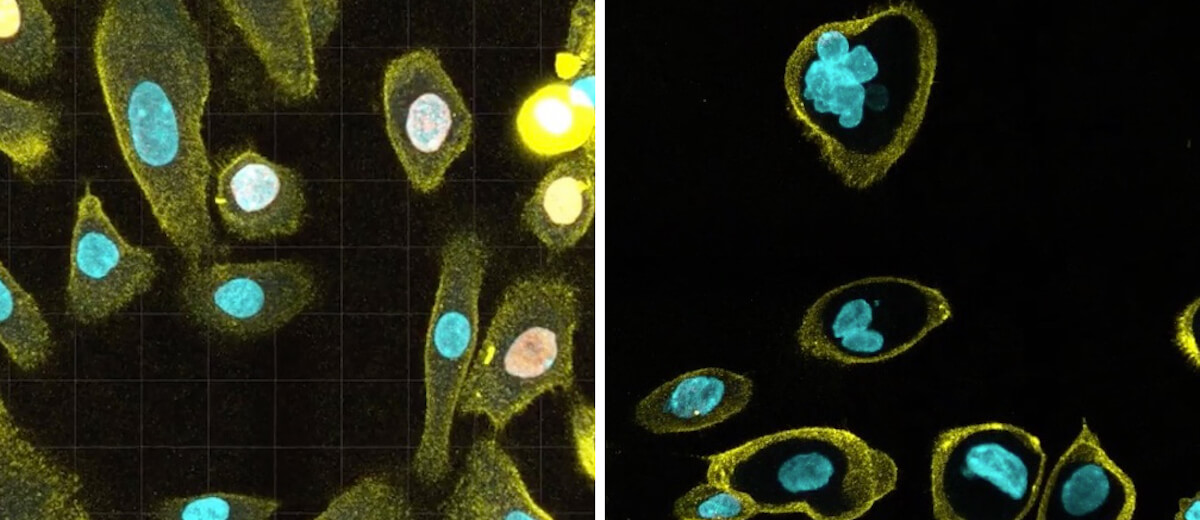The work, from USC Viterbi Assistant Professor in the Mork Family Department of Chemical Engineering & Materials Science, Nick Graham and his team in collaboration with Scott Fraser, Provost Professor of Biological Sciences and Biomedical Engineering, and Pin Wang, Zohrab A. Kaprielian Fellow in Engineering, was recently published in the Journal of Biological Chemistry.
“To drink from the fountain of youth, you have to figure out where the fountain of youth is, and understand what the fountain of youth is doing,” Graham said. “We’re doing the opposite; we’re trying to study the reasons cells age, so that we might be able to design treatments for better aging.”
How do Cells Age?
To achieve this, lead author Alireza Delfarah, a graduate student in the Graham lab, focused on expanding our knowledge of senescence, a natural process in which cells permanently stop creating new cells. This process is one of the key causes of age-related decline, manifesting in diseases such as arthritis, osteoporosis and heart disease.
“Senescent cells are effectively the opposite of stem cells, which have an unlimited potential for self-renewal or division,” Delfarah said. “Senescent cells can never divide again. It’s an irreversible state of cell cycle arrest.”
The research team discovered that the aging, senescent cells they studied stopped producing a class of chemicals called nucleotides, which are the building blocks of DNA. When they took young cells and forced them to stop producing nucleotides, they became senescent, or aged.
“This means that the production of nucleotides is essential to keep cells young,” Delfarah said. “It also means that if we could prevent cells from losing nucleotide synthesis, the cells might age more slowly.”
Graham’s team examined young cells that were proliferating robustly and fed them molecules labeled with stable isotopes of carbon, in order to trace how the nutrients consumed by a cell are processed into different biochemical pathways.
Scott Fraser and his lab worked with the research team to develop 3D imagery of the results. The images unexpectedly revealed that senescent cells often have two nuclei, and that they do not synthesize DNA.

Left: Non-senescent cells were shown with different colors. Right: Senescent cells appeared often with multiple blue nuclei and did not synthesize DNA.
Before now, senescence has primarily been studied in cells known as fibroblasts, the most common cells that comprised the connective tissue in animals. Graham’s team is instead focusing on how senescence occurs in epithelial cells, the cells that line the surfaces of the organs and structures in your body. These are also the types of cells in which most cancers arise.
Graham said that senescence is most widely known as the body’s protective barrier against cancer: When cells sustain damage that could be at risk of developing into cancer, they enter into senescence and stop proliferating so that the cancer does not develop and spread.
“Sometimes people talk about senescence as a double-edged sword, that it protects against cancer, and that’s a good thing,” Graham said. “But then it also promotes aging and diseases like diabetes, cardiac dysfunction or atherosclerosis and general tissue dysfunction,” he said.
Graham said the goal was not to completely prevent senescence, because that might unleash cancer cells. “But then on the other hand, we would like to find a way to remove senescent cells to promote healthy aging and better function,” he said.
Drugs to Help Humans Grow Older More Comfortably

Senolytic drugs could vastly improve human wellbeing in old age. IMAGE/PIXABAY
Graham said that the team’s research has strong applications in the emerging field of senolytics, the development of drugs that may be able to eliminate aging cells. He said that human clinical trials are still in early stages, but studies with mice have shown that by eliminating senescent cells, mice age better, with a more productive life span.
“They can take a mouse that’s aging and diminishing in function and give it these senolytic drugs to eliminate the senescent cells and the mouse is rejuvenated. So if anything it’s these senolytic drugs that are the fountain of youth,” Graham said.
He added that in order for successful senolytic drugs to be designed, it was important to identify what is unique about a senescent cell, so the drug won’t affect the normal, non-senescent cells.
“That’s where we’re coming in—studying senescent cell metabolism and trying to figure out how the senescent cells are unique, so that you could design targeted therapeutics around these metabolic pathways,” Graham said.
Published on July 25th, 2019
Last updated on February 9th, 2021












